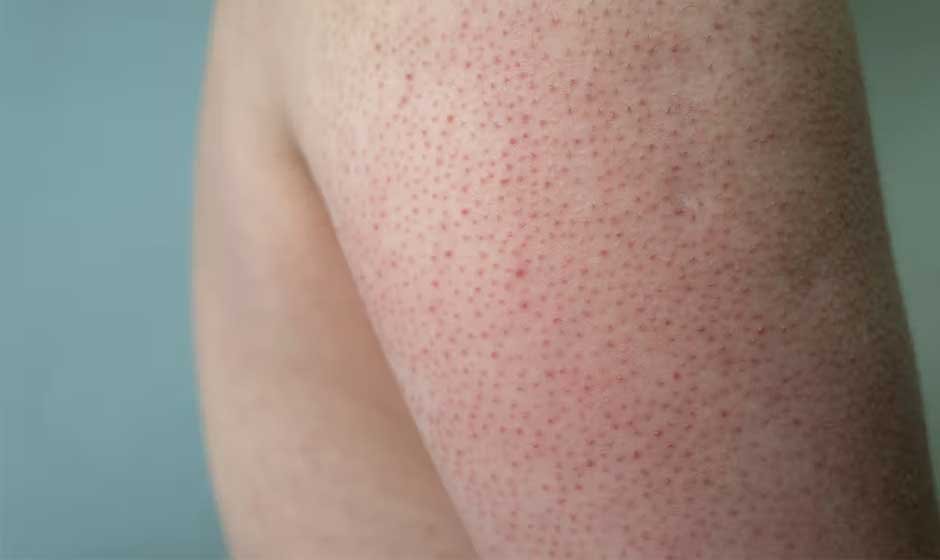Skip to the good bit
ToggleEver notice tiny, rough bumps on the back of your arms, thighs, or cheeks that look a bit like goosebumps or sandpaper? You might be dealing with a common, harmless skin condition known as keratosis pilaris.
While it doesn’t cause discomfort or health risks, many people want to treat it for cosmetic reasons. Here’s what you need to know about what causes keratosis pilaris, who it affects, and what you can do to smooth things out.
What Is Keratosis Pilaris?
Keratosis pilaris (often shortened to KP) is a skin condition caused by the buildup of keratin, a protein that helps protect the skin. When keratin clogs hair follicles, it forms tiny, hard bumps—sometimes called “chicken skin”—that may appear red, white, or flesh-colored.
KP often shows up on:
- Upper arms
- Thighs
- Cheeks
- Buttocks
It’s not contagious or dangerous, but it can be persistent and sometimes frustrating to manage.
What Causes Keratosis Pilaris?
The exact cause isn’t fully understood, but KP seems to be genetic. If one or both of your parents have it, you’re more likely to develop it too.
It also tends to show up more often in:
- People with dry skin or eczema
- Children and teenagers (it often improves with age)
- Individuals living in dry or cold climates, especially in the winter
Hormonal changes, such as those during puberty or pregnancy, can also trigger or worsen the condition.
Symptoms to Look For
Once you know what to look for, Keratosis pilaris is pretty easy to recognize. Common signs include:
- Small, rough bumps that feel like sandpaper
- Patches that may be slightly red or inflamed
- Skin that feels dry or itchy near the bumps
- A tendency to flare up during colder months
Unlike acne, these bumps usually don’t hurt or come to a head.
Can Keratosis Pilaris Be Cured?
There’s no permanent cure for keratosis pilaris, but the good news is that it’s highly manageable. For many, the condition improves with age, and consistent skincare can make a noticeable difference in texture and appearance.
How to Treat Keratosis Pilaris at Home
While KP can’t be completely erased overnight, here are some proven ways to keep your skin smoother and less irritated:
1. Exfoliate Gently
Use a chemical exfoliant with alpha hydroxy acids (AHAs) like glycolic acid or beta hydroxy acids (BHAs) like salicylic acid. These ingredients help dissolve dead skin cells and keratin buildup.
Avoid harsh scrubs, which can irritate the skin and make things worse.
2. Moisturize Daily
Hydration is key. Look for lotions or creams with:
- Urea (softens keratin)
- Lactic acid (exfoliates and hydrates)
- Ceramides (repair the skin barrier)
Apply immediately after showering to lock in moisture.
3. Use Lukewarm Water
Hot water can dry out the skin. Try to keep showers short and use gentle, fragrance-free cleansers.
4. Stick to a Routine
Keratosis pilaris responds best to consistent care. It can take several weeks to see improvements, so be patient and avoid picking at or scrubbing the bumps.
When to See a Dermatologist
If your KP doesn’t respond to over-the-counter treatments, or if it becomes painful, severely itchy, or inflamed, a dermatologist can help. Prescription creams with stronger concentrations of exfoliating or moisturizing agents can speed up results. In rare cases, laser treatments may be recommended for redness or scarring.
Embracing Skin Texture
It’s important to remember: keratosis pilaris is incredibly common and completely normal. Many people, including celebrities, have it, and it doesn’t define your skin’s beauty or health.
Whether you choose to treat it or simply let it be, knowing the facts about KP can help you make the best decision for your skin and your confidence.







